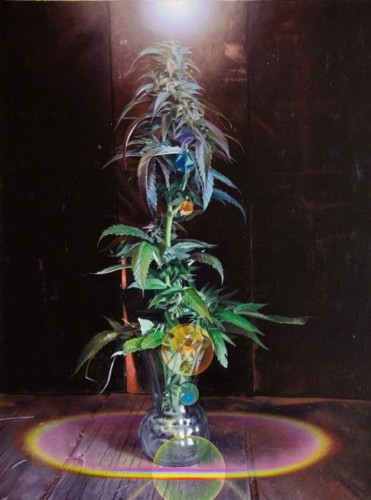Artists aren’t so quick to respond to social change. It’s not that they don’t care, of course, it’s just that art doesn’t work that way.
Conceiving and executing art — figuring out what to say and how to say it — take time. Add to that technical things, like printing, framing and paint-drying, and then logistics, like finding a spot on the schedule of a busy gallery.
So, it’s not that surprising that, more than a year after the legalization of marijuana, we are finally seeing multiple reflections on the cannabis revolution in formal exhibitions. David B. Smith Gallery is showing realistic portraits of pot plants by talented painter Paul Jacobsen. The Colorado Photographic Arts Center has a trio of artists in an exhibit that looks at the intersection of marijuana culture and commerce.

Both shows were worth the wait. They’re full of thought and a bit of creative wackiness. Jacobsen’s oils are meticulous, with the careful details of 17th-century Dutch masters. The arts center show puts still-developing variables side-by-side, contrasting shots of Colorado’s increasingly mechanized pot factories with humble farms in California where weed is still grown underground, literally, in mostly illegal operations.
The shows have little in common materially, but both attempt to document a shift in how we think about pot, how it is becoming a part of our everyday lives, shedding its stigma, normalizing.
And in a way, the shows are part of that movement themselves. Marijuana images on the walls of a fine-arts establishment? Well, that can’t be bad for a plant’s image.
Jacobsen’s exhibition is impressive in every way, eight or so paintings plus an architectural construction, made from salvaged building timbers that moves it toward an installation.
The images started as photographs taken at a cabin in Rico that the New York artist purchased a few years back. They are, for the most part, arranged cuttings, leafy, curvy, budding and lush; pot porn, if you will.
Jacobsen poses the plants formally, centered and under bright light, then paints them with all the seriousness of Cézanne and his oranges. The canvases glow like portraits of saints, resonating with otherworldly light.
Wisely, the artist brings us back to earth, reminding viewers that these are just photos captured in oil. He even paints the camera flash that was on the original digital print. He leaves in the context of the cabin itself; these images were captured in something resembling an abandoned dynamite shack.
The culture of cannabis
Wine and weed: A guide to flavor, pot pairings, wine profiles
High Style Icon: Willie Nelson, forever cool as fearless cannabis advocate
Botanical beauty: Surprise your stoner sweetie with a bud bouquet
Watch The Cannabist Show. Follow The Cannabist on Twitter and Facebook
Marijuana may be the subject of political discussions, or big business, but it is ultimately a product of seed and dirt. The giant timber construction in the gallery — resembling the roof frame for an old shed — evokes a frontier sensibility. Pot is having its moment, that reminds us, but the plant is as natural and enduring as any of the crops or minerals that made the West what it is today.
The evolution of cannabis is more of a documentary subject at the photographic arts center, and the view is less flattering. Curator Rupert Jenkins gives one wall over to H. Lee’s “Grassland,” 23 pictures of a marijuana farm in rural California. These are contemporary views of timeless agriculture, low-tech and connected closely to the land — scenes of trimming and sorting done by hand, home-made greenhouses and sun-worn drying sheds. They would be downright bucolic, if the farm weren’t skirting the law by producing the substance in a state where it remains outlawed.
The opposing wall has 15 images by photojournalist Benjamin Rasmussen, who has been shooting the evolving grow factories along the Front Range for various publications, including The New York Times. His world is dominated by sterile industrial facilities, warehouses where the light is artificial and workers wear gloves and masks, where pot is packaged by machines, sold in chic retail shops, paid for in fat wads of cash.
Both photographers have their eye, but curator Jenkins sees the big picture, summed up in the exhibition title “Mixed Bag.” Less than two years legal, marijuana is already losing its age-old essence, going from crop to commodity, from natural to engineered. The pictures are pretty, but it’s not a pretty picture.
Completing his show is a series of animations created by photographer Theo Stroomer, who has been focusing his lens on the various public festivals celebrating the great liberation of marijuana. His shots are alternately joyous and troubling, too, a mix of happy partiers and folks who look to be indulging a drug addiction. The scenes are well-crafted and very complicated.
As responses go, both the photography and Smith shows get at the feelings a lot of people have about marijuana in Colorado. We’re happy it’s legal; we chose that because we’re going to smoke it anyway; it does good things for good people who don’t deserve to go to jail for using it.
But it makes us think, too, about where it came from, and where it’s going, and how this revolution is unfolding, about who will win and who will lose.
Ray Mark Rinaldi: 303-954-1540, rrinaldi@denverpost.com or twitter.com/rayrinaldi
“Mixed Bag”
The Colorado Photographic Arts Center presents recent work on the subject of marijuana by Benjamin Rasmussen, H. Lee and Theo Stroomer. Through June 27. 1513 Boulder St. Free. 303-837-1341 or cpacphoto.org.
“Outpost”
David B. Smith Gallery presents an exhibit featuring new oil paintings by Paul Jacobsen. Through May 30. 1543 Wazee St. Free. 303-893-4234 or davidbsmithgallery.com.
